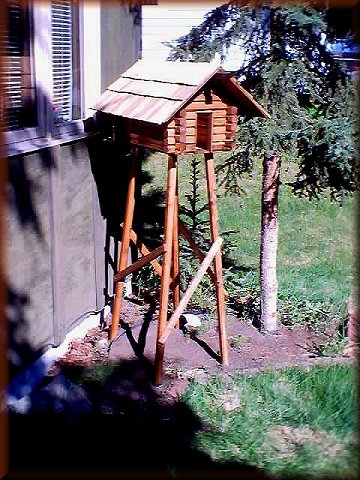
Garden Cache

For years my wife has been saying that my woodworking is "cheaper than paying a therapist." Recently while in Anchorage I capitalized on her view and had a chance to get a lot of "sawdust therapy." Beginning with nothing more than three 2x6s that were purchased for a different project, I started cutting and chamfering and fitting. In the end, we ended up with a cache to stand in the flower garden in front of the house.
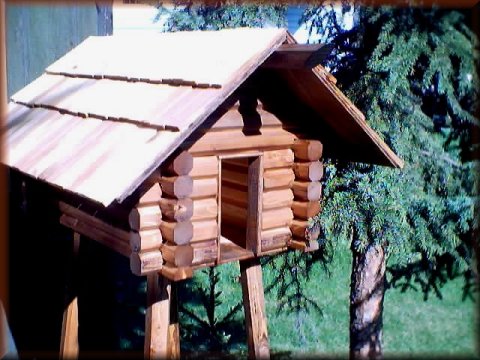
The term "cache" means to store something. In Alaska, cache's are a common site in the bush. Urbanites use them as lawn ornaments (not unlike the ubiquitous gnomes you see herding concrete turtles).
Caches are generally built of logs and raised off the ground to keep the animals from getting into the foodstuffs stored within. Size and height vary depending on the builder. Based on those that I have seen, the average size is probably close to 6 feet by 6 feet. The largest I have seen is at the Biederman Fish Camp on the Yukon River in Yukon-Charley Rivers National Preserve. It measures approximately 10 feet by 15 feet and sits only five feet off the ground. One of the things that I find amazing about most of the caches I am acquainted with is the long, deep claw marks made by bears attempting to gain access to them.
Our cache, measures 24 inches by 16 inches. It stands 4 feet off the ground. The pine "logs" measure 1 1/2 inches in diameter and were made by ripping down several 2x6s. The sharp corners were then chamfered 1/2 inch on each side to give them a roughly "round" appearance. The legs were made the same way. The cross-members are the left over edges of the 2x6s after ripping them. The roof is made of 1/2 inch plywood with cedar shims glued and nailed to resemble cedar shakes. The final touch is a screw hook centered beneath the cache to hang a basket of flowers. Because things have a tendency to grow mobile legs, even in Alaska, the cache is secured to the house by a 5/16 inch by 6 inch eye screw into a stud in the house connected to a 5/16 inch by 4 inch eye bolt secured through the back of the cache.
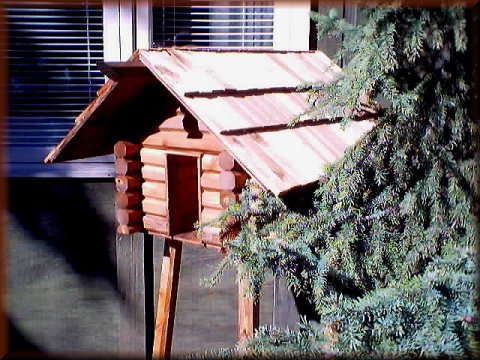
The pine is stained using a Behr oil based stain. I chose the color Danish Walnut to bring out the grain in the wood and to give it a slightly "aged" appearance. While watering the flowers I found that the oil stain also provides good protection for the wood against water. The pseudo-shakes shed water great!
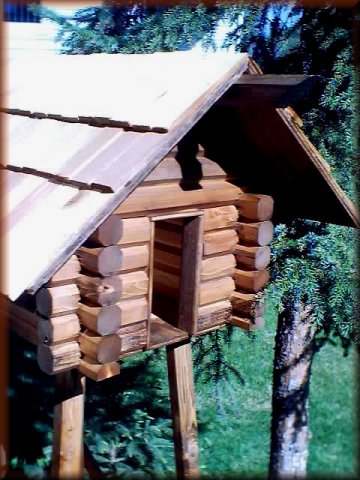
If I were to make another one, instead of using pine 2x6s, I think I would prefer to use cedar. Rather than chamfering the edges, I would set up a router with a 1/2" roundover bit to give the logs an actual rounded appearance.
Finally, I decided to leave the door off in hopes that we might have a family of squirrels or birds decide to take up residence in the cache.
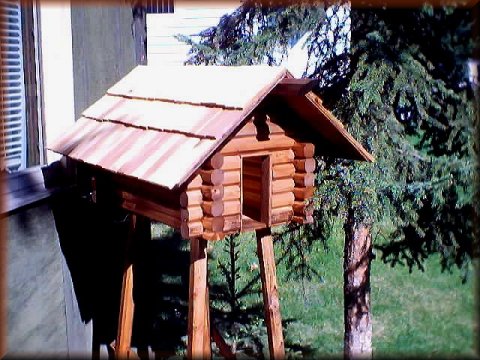
Some may ask about the actual cost of building this cache. Well, the boards were purchased for another project, the plywood was left over from other projects (I save all my scrap lumber since I never know when I may need a small piece for something). The stain was purchased for 50 cents a number of years ago when a local department store went out of business. The only real expense for the project was for the cedar shims. Originally I figured it would take six packages (of 14 shims per package). I bought eight just in case. In the end, I had to buy two more to finish the roof. After it was completed, there were two shims left over. So, actual out of pocket expenses ... $10. Total time to construct it ... two to three hours a day over three days (less than 10 hours total).
Now, what would I sell it for? Well, we looked at a similar cache at a local feed store. It was made of square 2x2s, butted at the corners (mine has rounded notching at the corners), a plain plywood roof, about half this size, and unfinished. The price tag read $125. So, realistically, I would have to put a price tag on this one somewhere in the neighborhood of $200. My daughter says I could sell a "gazillion" of them on the Internet. Perhaps I have come up with a source of "retirement income." I would just hate to pay the shipping on them!
May 24, 2002